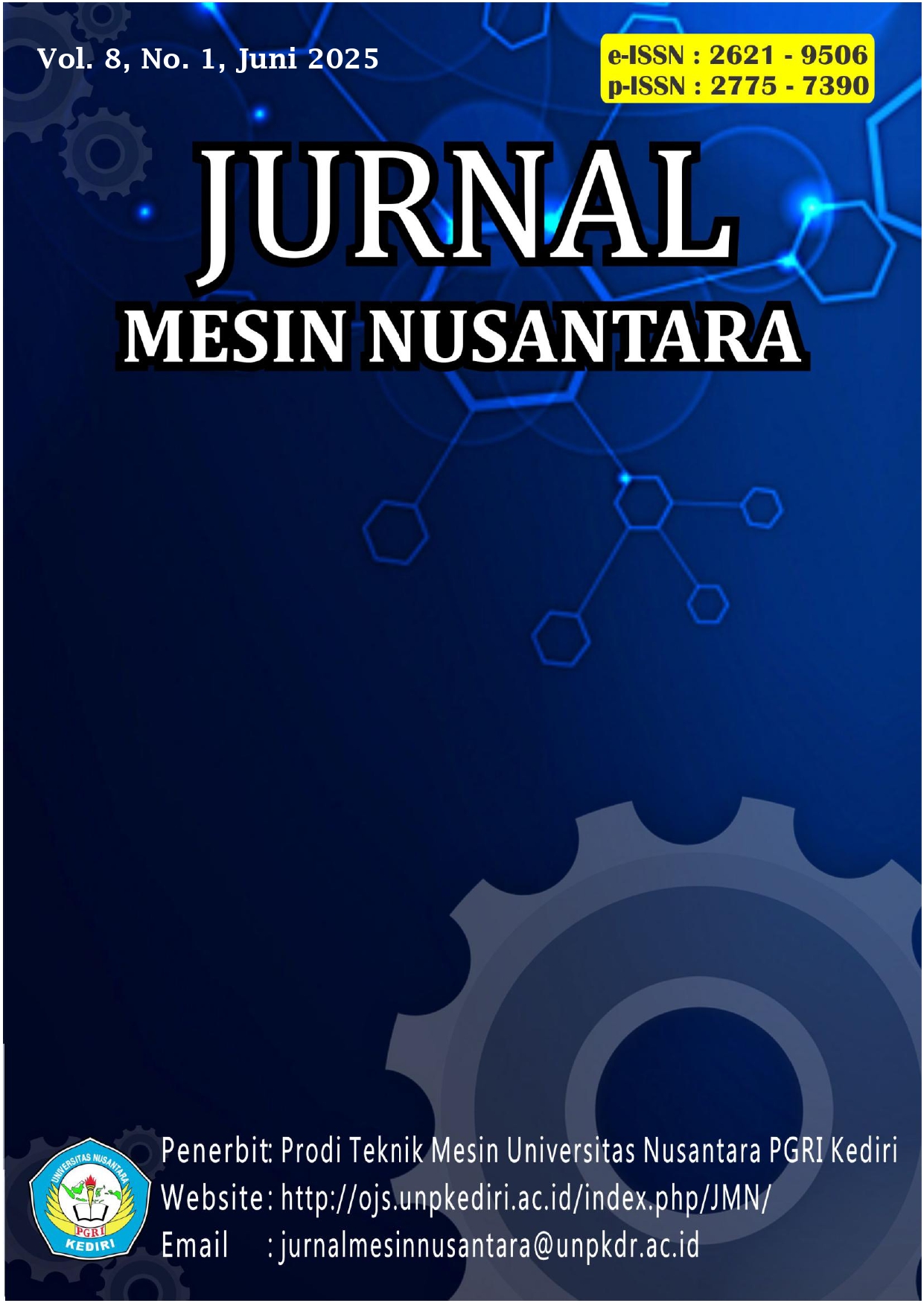Analisis Kinerja Mesin Circular saw Berorientasi Potong 45-90 Derajat Untuk Aplikasi Industri Kayu Studi Eksperimental
DOI:
https://doi.org/10.29407/jmn.v8i1.24694Keywords:
Mesin gergaji circular, analisis kinerja, kekasaran permukaan, keakuratan pemotonganAbstract
Penelitian ini menganalisis performa mesin circular saw yang dapat beroperasi pada sudut 45-90 derajat dalam industri kayu, menggunakan kayu sengon, meranti, dan jati. Parameter yang diuji meliputi kecepatan pemotongan, akurasi potongan, dan keandalan operasional, menggunakan Surface Roughness Tester dan Digital Angle Ruler. Hasil menunjukkan kayu sengon dan meranti mencapai kehalusan terbaik pada sudut 65 derajat, sementara jati menunjukkan kehalusan konsisten. Keakuratan sudut potong sangat baik pada semua sudut yang diuji. Desain dan kualitas mata gergaji serta kalibrasi mesin mempengaruhi presisi dan kehalusan potongan. Rekomendasi mencakup pemilihan mesin dengan kemampuan sudut potong variabel, kalibrasi dan perawatan rutin, serta pemahaman sifat material kayu untuk menentukan sudut potong dan jenis mata gergaji optimal. Temuan ini membantu industri kayu meningkatkan produktivitas dan kualitas produk.
Downloads
References
[1] E. Yosefi Suryandari, “Analisis Permintaan Kayu Bulat Industri Pengolahan Kayu,” J. Penelit. Sos. dan Ekon. Kehutan., vol. 5, no. 1, hal. 15–26, 2008, doi: 10.20886/jpsek.2008.5.1.15-26.
[2] I. W. Sutarman, “Pemanfaatan Limbah Industri Pengolahan Kayu di Kota Denpasar (Studi Kasus pada CV Aditya),” J. Penelit. dan Apl. Sist. dan Tek. Ind., vol. 10, no. 1, hal. 15–22, 2016.
[3] S. Mulyadi, “Pengaruh Kecepatan Potong, Gerak Makan Dan Ketebalan Pemotongan Terhadap Getaran Benda Kerja Pada Proses Sekrap,” Rotor Tek. Mesin, vol. 5, no. 1, hal. 38–39, 2012.
[4] R. Wahyuniardi, L. H. Afrianti, S. Nurjaman, dan W. Gusdya, “Sistem Informasi Berbasis Web Untuk Monitoring Dan Evaluasi,” J. Ilm. Tek. Ind., vol. 14, no. 2, hal. 174–186, 2016.
[5] W. Wahjono, “Peran Manajemen Operasional dalam Menunjang Keberlangsungan Kegiatan Perusahaan,” J. Ilm. Infokam, vol. 17, no. 2, hal. 114–120, 2021, doi: 10.53845/infokam.v17i2.302.
[6] D. W. Ariani, “Manajemen operasi jasa.” Universitas Terbuka, 2011.
[7] C. A. P. PRADINA, “ANALISIS PENGOLAHAN LIMBAH KAYU LAPIS DALAM MENINGKATKAN KESEJAHTERAAN MASYARAKAT”.
[8] A. Fahruddin dan M. Mulyadi, “Rancang Bangun Alat Uji Head Losses Dengan Variasi Debit Dan Jarak Elbow 90O Untuk Sistem Perpipaan Yang Efisien,” Turbo J. Progr. Stud. Tek. Mesin, vol. 7, no. 1, hal. 32–35, 2018, doi: 10.24127/trb.v7i1.680.
[9] A. Supriyanto, “PENGOLAHAN LIMBAH PRODUKSI MEBEL KAYU SEBAGAI PRODUK INOVATIF DI DESA MANGGUNG KECAMATAN NGEMPLAK KABUPATEN BOYOLALI,” 2019.
[10] D. Hamdani, I. Irzal, N. Helmi, dan R. Rifelino, “Effect of Cutting Condition on the Surface Roughness Level of ST 42 Steel in Conventional Lathe Processes,” Motiv. J. Mech. Electr. Ind. Eng., vol. 2, no. 3, hal. 11–20, 2020, doi: 10.46574/motivection.v2i3.64.
Downloads
Published
Issue
Section
License
Copyright (c) 2025 Dafva Ari Perbawa, Ali Akbar, Rachmat Firdaus, Mulyadi Mulyadi

This work is licensed under a Creative Commons Attribution-ShareAlike 4.0 International License.
Authors who publish with this journal agree to the following terms:
- Copyright on any article is retained by the author(s).
- The author grants the journal, right of first publication with the work simultaneously licensed under a Creative Commons Attribution License that allows others to share the work with an acknowledgment of the work’s authorship and initial publication in this journal.
- Authors are able to enter into separate, additional contractual arrangements for the non-exclusive distribution of the journal’s published version of the work (e.g., post it to an institutional repository or publish it in a book), with an acknowledgment of its initial publication in this journal.
- Authors are permitted and encouraged to post their work online (e.g., in institutional repositories or on their website) prior to and during the submission process, as it can lead to productive exchanges, as well as earlier and greater citation of published work.
- The article and any associated published material is distributed under the Creative Commons Attribution-ShareAlike 4.0 International License












